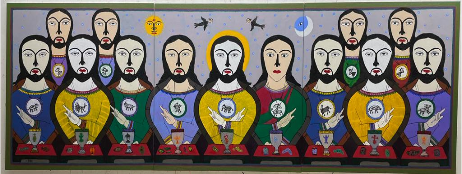While cries of feminism and upholding women’s rights become larger around March, when International Women’s Day is scheduled, in reality, womanhood needs to be celebrated every day and in myriad ways. This is why the National Gallery of Modern Art, India (NGMA) and Museum of Sacred Art, Belgium (MOSA) joined hands to present their ongoing exhibition titled ‘Shakti: Fair & Fierce: An exhibition of women artists that celebrates feminine creativity and empowerment’ at NGMA Delhi.
It has been curated by Sushma K. Bahl with curatorial inputs from Meghna Vyas Arora, and is on display till April 30. “The exhibition articulates women’s voices and visions sieved through 100-plus multi-layered works by 55 female artists currently working in varied genres and living in different parts of India,” explains Bahl.
The project relies heavily on mythological narratives, as well as other themes of female empowerment through paintings, drawings, prints, sculptures, installations, animated works, digital works, videos, pop art and embroideries along with some mixed media works. The focus is on the many concerns of women and their life experiences.
In Bahl’s words, “The collection manifests the vitality of women’s multi-faceted creative engagement which goes beyond a limited domestic periphery onto wider and varied domains of interest to them and the larger society. The tapestry of artworks spans varied domains, dimensions, techniques, genres, and themes.” The exhibition is set to move to Mumbai after it wraps up in Delhi, and later will also be shown in Uruguay and Belgium.
“Shakti, the source of all energy, is personified as a divine goddess and feminine principle, not just in Hindu philosophy but in theologies around the world. Her dynamic energy is the spring for creation, sustenance, demolition, and regeneration of life in the universe. Fair and fierce, the nurturing and compassionate woman is Shakti. Her fair streak is symbolised as love, warmth, generosity, and fertility, not just the colour of her skin as often misrepresented in advertisements, movies, and media. Her fierce aspect signifies a resilience that can confront injustice and violence. Though described and revered as Ardhangini (wife/ better-half), Grih-Laksmi (goddess of household prosperity), Sarasvati (the epitome of knowledge and wisdom) Durga (warrior goddess), Ardhnarishwar (composite androgynous divinity), and in numerous other forms, fables and avatars (incarnations), as per ancient Indian civilizational history, her body and image though, is violated in real life,” says Bahl.
She continues by highlighting that since time immemorial, women have been depicted as being “feeble and subservient”, and being subjected to “rigid gender constructs, discrimination, sexual exploitation, marginalization, and violence, at home, in society and at work” all over the world. “This exhibition offers women an outlet for self-release by showcasing their creative acumen. It enhances their self-confidence, gives them a feeling of independence, a sense of achievement and a source of earning a living. The multifarious feminine art adds a profound layer to India’s vast and varied artistic landscape that extends to include political, armed forces, corporate and technical spheres.”
“I am awed by the creative energy emerging from this selection of women artists from India. The variety and intensity of their artistic expressions shows the vibrancy of the Indian contemporary art scene as well as the enduring traditional art forms. In this case some amazing embroidery work is also on display. I believe this is a symbolic representation as the number of women contemporary artists and traditional artists are in the millions. That is the mesmerizing scale of the Indian creative economy,” says Mr Martin Gurvich, the director of MOSA, Belgium.
Most of the works on display are new and reflective of the varied work of the many artists brought together to participate in it. There are internationally acclaimed senior artists like Madhvi Parekh, Jayasri Burman and Arpana Caur as well as renowned names like Shantamani Muddaiah, Shobha Broota, Radha Gomaty, Sujata Bajaj and Brinda Miller. Each of them converses in a feminine discourse within broader social contexts.
A number of emerging artists like Keerti Pooja and Sonal Varshneya focus their work on women in familiar domestic surroundings through their drawings and etchings. The digital medium is explored by Richa Navani and photographer Saadiya Kochar. They show the role of the divine feminine in bolstering women through the many struggles they face. The colourful creations of multi-media artists Seema Kohli and Kanchan Chander and sculptor Nivedita Mishra further push the boundaries of questioning women’s subjugation and highlighting their vital contributions to society.
Sangeeta Gupta uses textile and block printing to highlight the work of traditional artisans trained in creating beautiful embroidery. “Effectively combining heritage and traditions with modernity and innovation, their art raises voices against women’s socioeconomic marginalization and exploitation, asserting the feminine right to equity,” shares Bahl. It is interesting to see the juxtaposition of traditional handicraft installations with technology-inspired work. From the Chamba Rumal of Himachal Pradesh, to the Kantha embroidery of West Bengal, the Kashidakari of Kashmir, the Rabari of Kutch, and the Sujani and Khatwa of Bihar, all show the sheer variety of artistic mediums that women have propagated and practiced for centuries, as part of their domestic lives.
To accompany the exhibition, an in-depth catalogue was released earlier this month. It contained descriptions and photos of the artworks as well as thought-provoking essays by Bahl and Sujata Prasad, on the important themes explored in this exhibit.
Bahl concludes with, “The collection mainstreams Indian feminine Shakti and puts it on an international circuit, as it builds bridges between the male/female gender divide and gaze. It articulates the need for dismantling the modernity/tradition, art/craft, urban/rural, and high/low art dichotomy in pursuit of a wholesome and inclusive society.”
Noor Anand Chawla pens lifestyle articles for various publications

